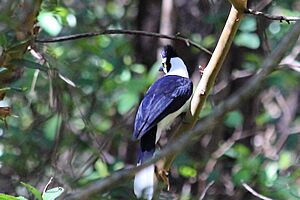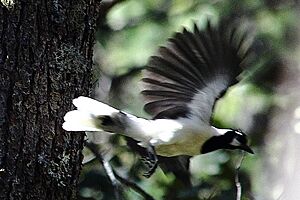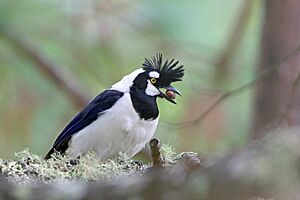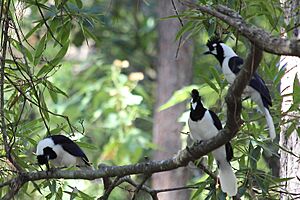Tufted jay facts for kids
Quick facts for kids Tufted jay |
|
|---|---|
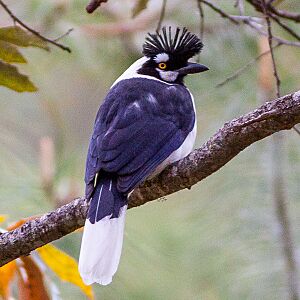 |
|
| In Sinaloa, Mexico | |
| Conservation status | |
| Scientific classification | |
| Genus: |
Cyanocorax
|
| Species: |
dickeyi
|
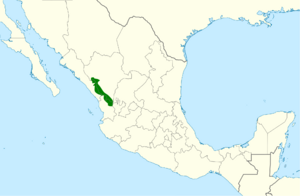 |
|
| Distribution of the tufted jay Year-round | |
The tufted jay (Cyanocorax dickeyi) is a cool bird from the crow family, Corvidae. It's also called the painted jay or Dickey's jay. You can only find this bird in a small part of Mexico, in the Sierra Madre Occidental mountains. This area includes parts of Sinaloa, Durango, and Nayarit.
This large jay is easy to spot! It has a big, dark crest (like a fancy hairdo) on its head. Its back, wings, and face are a pretty purplish-blue. It has white spots above its eyes and on its cheeks, and its belly is white. Its tail is also partly white. When it calls, it makes a quick, four-note sound.
Scientists have been very interested in how the tufted jay is related to other jays in its group, Cyanocorax. For a while, people thought it was closely related to the white-tailed jay because they look similar. But a study in 2010 looked at their mitochondrial DNA (a type of genetic material). This study showed that the tufted jay is actually most closely related to a group of jays that live far away in South America. Even though they are separated by more than 2,000 kilometers (about 1,240 miles)! This suggests that their ancestors once lived all across Central and South America.
Tufted jays live in pine-oak forests, usually staying high up in the tree tops. They mostly eat berries and fruit. They also munch on insects like katydids. These birds are very social! They live in flocks that are usually centered around one breeding pair. Some of these flocks stay together for many years. The tufted jay's breeding season starts in late March. The flock works together to build a nest where the female lays two to five eggs. The tufted jay is currently listed as near threatened by the International Union for Conservation of Nature (IUCN). This means its population is decreasing. There are only about 10,000 to 20,000 adult birds left in the wild. The biggest threats to them are losing their homes because of farming and trees being cut down.
Contents
Discovering the Tufted Jay
The tufted jay was first described by a bird expert named Robert Thomas Moore in 1935. He studied birds that were collected in Mexico in 1934. Because the tufted jay lives in such a small area, it wasn't found during earlier trips, even when explorers passed close by!
Moore put this new bird in the group Cyanocorax. He named it Cyanocorax dickeyi to honor another bird expert, Donald Ryder Dickey. The tufted jay does not have any different types or "subspecies" that scientists recognize.
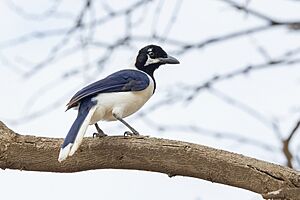
When Moore first described the tufted jay, he noticed it looked a lot like the white-tailed jay from Ecuador. That's over 4,800 kilometers (about 3,000 miles) away! This made scientists wonder if they came from a common ancestor that lived across Central and South America a long time ago.
Some scientists even thought the tufted jay might be the same species as the white-tailed jay. They thought differences in color could be explained by where they lived. Or that maybe white-tailed jays were brought to Mexico by ancient trade. But a 2010 study using mitochondrial DNA showed that the tufted jay and white-tailed jay are actually not "sister species" (meaning they don't share a very recent common ancestor). Instead, the tufted jay is more closely related to other jays found in South America, like the white-naped jay, cayenne jay, and plush-crested jay. This study suggested that their common ancestor was once spread out over a very large area.
What Does a Tufted Jay Look Like?
The tufted jay is a very unique bird in its home range. It has a crest of black feathers on its head that turns dark blue at the bottom. Its face is mostly black or dark blue. It has cool white spots above its eyes and white cheeks. The back of its neck and its belly are white. Its back and wings are a beautiful purplish-blue color. This color goes partway down its tail, then the tail turns white about halfway down.
Its beak and legs are black, and its eyes are bright yellow! Young tufted jays look a bit different. They have shorter crests and no white spot above their eyes. Their cheeks are bright blue, and their eyes are brown. They keep this look until they shed their feathers in their second year. The base of their beak is pinkish when they are young, but it turns black after a few months. Male and female tufted jays look exactly the same. When they fly, they look "buoyant" and flap their wings constantly. We don't know how long tufted jays usually live.
The tufted jay is a large bird, measuring about 35.5 to 38 centimeters (14 to 15 inches) long. Males are usually a little bigger than females. For example, males have slightly longer wings and tails. On average, a tufted jay weighs about 181 grams (6.4 ounces).
The tufted jay looks a bit like the black-throated magpie-jay. But the magpie-jay is bluer, has a bigger crest, and a much longer tail. It's also brighter in color. The tufted jay also looks similar to the white-tailed jay, but they don't live in the same places. Compared to the white-tailed jay, the tufted jay has a bigger crest, no white on its outer wings, and more white on its tail.
Tufted Jay Sounds
Tufted jays make several different sounds. Their most common call is a fast, four-note sound. People write it as rak, chuck, chen, or ca. Flock members use this call when they are eating, and nesting females use it too. A higher-pitched version of this call is used when they are mobbing (ganging up on) a predator.
When they are sitting next to other jays, they might make a nasal aaagh sound. Males guarding a nest make a tuk or tst call. Tufted jays are also known to copy the calls of other birds, like the blue mockingbird and the great-tailed grackle.
Where Tufted Jays Live
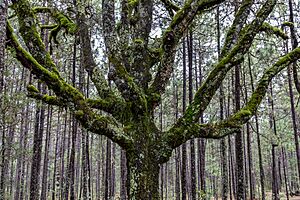
The tufted jay is only found in Mexico, in a small part of the Sierra Madre Occidental mountains. This area is about 193 by 32 kilometers (120 by 20 miles) big. You can find them in eastern Sinaloa, western Durango, and northern Nayarit.
These birds usually live at elevations between 1,500 and 2,000 meters (about 4,900 to 6,500 feet) high. But they have been seen as low as 1,200 meters (3,900 feet) and as high as 2,500 meters (8,200 feet).
Tufted jays live in forests. When it's not breeding season, they prefer higher pine-oak forests. During breeding season, you can often find them in ravines near water. They are almost always high up in the tree tops and are rarely seen on the ground.
Tufted Jay Behavior
What Tufted Jays Eat
Tufted jays eat fruits, acorns, and insects. Most of their diet (about 70%) comes from plants. This includes blackberries, nuts, acorns, and fruit from Peltostigma plants. The other 30% of their diet is made up of insects like katydids, beetles, and wasps. Tufted jays have also been seen eating eggs that they've taken from other birds' nests.
When it's not breeding season, tufted jays search for food in flocks. But in late March, when breeding season starts, they break into smaller groups to find food. They have clever ways to get food! They often sit on a branch and use their beak to pry, pull, or hammer at food. If a branch can't hold their weight, they might hang from a higher branch and reach down. Or they might quickly hover in front of the food to grab it. They also hide food for later and sometimes look for food in leaves on the ground.
During the breeding season, the whole flock works together to feed the female who is sitting on the nest. Flock members bring food back to the nest often. The nesting female might make a begging call and flap her wings when food arrives.
Social Life and Territories
The tufted jay is a very social bird! They live in flocks of 4 to 16 birds. The size of the flock changes during the year. It's bigger when they're not breeding and smaller during breeding season. Flocks usually have one breeding pair, other adult birds, and several young birds. Young male jays leave the flock when they are about 13 to 18 months old.
Groups of tufted jays stay together for a whole year, and some flocks even last for many generations! Different flocks usually live close to each other, but their territories (their home areas) don't often overlap. When they do defend their territory, it's usually around areas they use for breeding and finding food.
Tufted jays don't usually bother other bird species much. Sometimes, groups of Steller's jays will follow tufted jay flocks, and the two species just ignore each other. However, a tufted jay might dive at a Steller's jay if it gets too close to a nest or if the tufted jay is looking for food. On the other hand, some other birds, like white-eared hummingbirds and Aztec thrushes, have been seen mobbing tufted jays.
Reproduction and Nesting
The breeding season for tufted jays starts in late March. Each flock has only one breeding pair. The Nests are built together by the breeding female, young birds from the previous year, and other females in the flock. They build their nests high up in trees, usually 5 to 15 meters (about 16 to 49 feet) off the ground. The nests are about 41 centimeters (16 inches) wide and 6 centimeters (2.4 inches) deep. They are made of sticks, with the inside cup made of roots and smaller branches. Females will even sit in the nest before any eggs are laid!
Eggs are laid in April or May. A typical clutch (group of eggs) has two to five eggs. They are olive-colored with brown speckles. Each egg is about 36 to 38 millimeters (1.4 to 1.5 inches) long and 24 to 25.4 millimeters (0.9 to 1 inch) wide. Only the female will sit on the eggs to keep them warm. The male and other flock members bring food to the female while she incubates. The eggs hatch after 18 to 19 days.
Baby jays stay in the nest for about 24 days. They are born altricial (meaning they are helpless and don't have feathers yet). The whole flock helps feed the baby jays too. They pass food to the nesting female, who then gives it to the hatchlings. We don't know how old tufted jays are when they start breeding themselves.
Protecting the Tufted Jay
The tufted jay is listed as near threatened by the International Union for Conservation of Nature (IUCN). This means they are at risk of becoming endangered. As of 2020, their population is shrinking, with only about 10,000 to 20,000 adult birds left.
Since tufted jays live in a small area, the biggest dangers to them are habitat destruction (losing their homes) because of farms expanding, trees being cut down for wood, and forest fires. Habitat fragmentation (their home being broken up into smaller pieces) caused by roads is also a threat. People have also hunted or killed tufted jays. Dry weather (drought) is also a problem because it means less food for them. Climate change could cause more long droughts in the future, which might make their population drop even more. Some water sources they use have also been destroyed by human activities.
Even though there aren't many official plans just for the tufted jay, the Mexican government considers them endangered. They are also at high risk of extinction according to a group called Partners in Flight. Since 2004, a community in Sinaloa called El Palmito has had a conservation plan. Many tufted jays live near there. This plan tries to encourage ecotourism (tourism that helps nature) and education, while also limiting logging.



